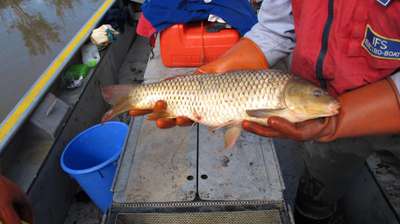Not So Carpy Christmas

In the lead up to the festive season, we have continued to pull out all the stops in the fight against carp in Tasmania. The remaining carp have been very active within inshore regions due to warm water and recent rain events. This has been the time to strike: they are very susceptible to our methods while in these shallow regions.
The importance of us using a wide range of methods to remove the few remaining carp from Lake Sorell has been paramount. All of our methods have resulted in the capture of carp, and this serves to target all individuals in a population based on varying behaviour and maturity. These methods include: gill netting, fyke netting, trapping, electro fishing, and targeted fishing based on radio tracking.
Only 69 carp have been captured since the beginning of September! During the same period last year, we had pulled 228 of them from the lake!
Upon processing these carp, we have found the following important data:
• 33 were females, 33 were males, 3 were indeterminate.
- 19 of the males were confirmed to have Jelly Gonad Condition (JGC). This is a naturally occurring condition that effects the gonads of male carp, likely making them infertile in advanced cases. A PhD research project on the condition is currently underway to further exploit the condition.
• 7 were ex radio-transmitter (tracker) carp. These fish where all released within the last year, and all possess JGC. These were released as low risk ‘Judas fish’ due to their compromised fertility. This is another indicator of the small population size; the fact that we are catching back these tracker carp in such a high proportion within the total catch.
• In addition to ex-tracker carp, the ratio of current tracker carp to wild carp running into our gill nets now stands at 16 trackers to 43 wild carp.
- There have only been 12 current tracker carp in the lake at any given time since September, so the fact that these fish continually run into our nets in such high proportions further demonstrates just how critically small the carp population now is.
We will continue to maintain maximum effort throughout the Christmas period and into the new year, making the most of this heightened inshore activity of carp.
Here’s to a not so carpy Christmas!